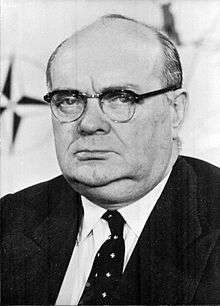Belgian general election, 1949
Belgian general election, 1949
.svg.png)
|
| 26 June 1949 (1949-06-26) |
|
|
All 212 seats in the Chamber of Representatives
106 seats in the Senate
107 (Chamber) seats needed for a majority |
| |
First party |
Second party |
| |
 |
 |
| Leader |
Gaston Eyskens |
Paul-Henri Spaak |
| Party |
Christian Social |
Socialist |
| Leader since |
Candidate for PM |
Candidate for PM |
| Last election |
92 seats, 42.54% |
69 seats, 31.57% |
| Seats won |
105 |
66 |
| Seat change |
 13 13 |
 3 3 |
| Popular vote |
2,190,895 |
1,496,539 |
| Percentage |
43.55% |
29.76% |
| Swing |
 1.01% 1.01% |
 1.81% 1.81% |
|
| |
Third party |
Fourth party |
| |
|
|
| Leader |
Roger Motz |
Julien Lahaut |
| Party |
Liberal |
Communist |
| Leader since |
1945 |
1945 |
| Last election |
17 seats, 8.93% |
23 seats, 12.69% |
| Seats won |
29 |
12 |
| Seat change |
 12 12 |
 11 11 |
| Popular vote |
767,180 |
376,765 |
| Percentage |
15.25% |
7.49% |
| Swing |
 6.32% 6.32% |
 5.20% 5.20% |
|
|
|
General elections were held in Belgium on 26 June 1949.[1] Several reforms took effect prior to the elections; they were the first after the introduction of universal women's suffrage; the number of seats in the Chamber of Representatives was increased from 202 to 212, and from now on, elections for the nine provincial councils were held simultaneously with parliamentary elections. The number of Chamber seats and the simultaneous provincial and parliamentary elections would remain unchanged until state reforms in 1993.
The result was a victory for the Christian Social Party, which won 105 of the 212 seats in the Chamber of Representatives and 54 of the 106 seats in the Senate.[2] Voter turnout was 94.4%.[3]
Results
Chamber of Deputies
| Party |
Votes |
% |
Seats |
+/– |
|---|
| Christian Social Party | 2,190,895 | 43.55 | 105 | +13 |
| Belgian Socialist Party | 1,496,539 | 29.76 | 66 | -3 |
| Liberal Party | 767,180 | 15.25 | 29 | +12 |
| Communist Party of Belgium | 376,765 | 7.49 | 12 | –11 |
| Flemish Concentration | 103,896 | 2.07 | 0 | New |
| Middle Class | 45,721 | 0.91 | 0 | New |
| Independent Party | 20,450 | 0.41 | 0 | New |
| Traders Union | 6,709 | 0.13 | 0 | New |
| National Belgian Rally | 6,077 | 0.12 | 0 | New |
| Walloon Unity | 5,852 | 0.12 | 0 | New |
| Luxembourg Defence | 2,024 | 0.04 | 0 | New |
| Cosmocraten | 685 | 0.01 | 0 | New |
| Light | 680 | 0.01 | 0 | New |
| Independent General Syndicate | 610 | 0.01 | 0 | New |
| Belgian Patriotic Party | 55 | 0.00 | 0 | New |
| Independents | 6,745 | 0.13 | 0 | 0 |
| Invalid/blank votes | 289,333 | – | – | – |
| Total | 5,320,216 | 100 | 212 | +10 |
| Registered voters/turnout | 5,635,452 | 94.41 | – | – |
| Source: Belgian Elections |
Senate
| Party |
Votes |
% |
Seats |
+/– |
|---|
| Christian Social Party | 2,208,553 | 46.95 | 54 | +3 |
| Belgian Socialist Party | 1,410,135 | 29.98 | 33 | –1 |
| Liberal Party | 762,530 | 16.21 | 14 | +10 |
| Communist Party of Belgium | 377,209 | 8.02 | 5 | –6 |
| Flemish Concentration | 66,055 | 1.40 | 0 | New |
| Middle Class | 37,302 | 0.79 | 0 | New |
| Independent Party | 20,357 | 0.43 | 0 | New |
| A | 13,379 | 0.28 | 0 | New |
| Traders Union | 5,507 | 0.12 | 0 | New |
| Walloon Unity | 5,010 | 0.11 | 0 | New |
| B | 555 | 0.01 | 0 | New |
| Independents | 5,241 | 0.12 | 0 | 0 |
| Invalid/blank votes | 321,017 | – | – | – |
| Total | 5,024,677 | 100 | 106 | +5 |
| Registered voters/turnout | 5,635,452 | 89.16 | – | – |
| Source: Belgian Elections |
Constituencies
The distribution of seats among the electoral districts of the Chamber of Representatives was as follows.[4] Several arrondissements got one or more additional seats.
References

